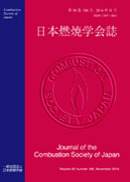Volume 61, Issue 198
Displaying 1-15 of 15 articles from this issue
- |<
- <
- 1
- >
- >|
FEATURE—Initiatives for Social Implementation of Ammonia Direct Combustion
-
Article type: FEATURE
2019Volume 61Issue 198 Pages 277-282
Published: 2019
Released on J-STAGE: November 15, 2019
Download PDF (1407K) -
Article type: FEATURE
2019Volume 61Issue 198 Pages 283-288
Published: 2019
Released on J-STAGE: November 15, 2019
Download PDF (2678K) -
Article type: FEATURE
2019Volume 61Issue 198 Pages 289-292
Published: 2019
Released on J-STAGE: November 15, 2019
Download PDF (2153K) -
Article type: FEATURE
2019Volume 61Issue 198 Pages 293-298
Published: 2019
Released on J-STAGE: November 15, 2019
Download PDF (2999K) -
Article type: FEATURE
2019Volume 61Issue 198 Pages 299-303
Published: 2019
Released on J-STAGE: November 15, 2019
Download PDF (1558K) -
Article type: FEATURE
2019Volume 61Issue 198 Pages 304-308
Published: 2019
Released on J-STAGE: November 15, 2019
Download PDF (2165K) -
Article type: FEATURE
2019Volume 61Issue 198 Pages 309-312
Published: 2019
Released on J-STAGE: November 15, 2019
Download PDF (2381K) -
Article type: FEATURE
2019Volume 61Issue 198 Pages 313-319
Published: 2019
Released on J-STAGE: November 15, 2019
Download PDF (3698K) -
Article type: FEATURE
2019Volume 61Issue 198 Pages 320-325
Published: 2019
Released on J-STAGE: November 15, 2019
Download PDF (2080K) -
Article type: FEATURE
2019Volume 61Issue 198 Pages 326-330
Published: 2019
Released on J-STAGE: November 15, 2019
Download PDF (3020K)
SERIAL LECTURE—Fundamentals and Applications of Combustion Measurement Technique IV
-
Article type: SERIAL LECTURE
2019Volume 61Issue 198 Pages 331-346
Published: 2019
Released on J-STAGE: November 15, 2019
Download PDF (3241K)
SOCIETY ACTIVITY NOTE
-
Article type: SOCIETY ACTIVITY NOTE
2019Volume 61Issue 198 Pages 354-357
Published: 2019
Released on J-STAGE: November 15, 2019
Download PDF (3742K) -
Article type: SOCIETY ACTIVITY NOTE
2019Volume 61Issue 198 Pages 358-360
Published: 2019
Released on J-STAGE: November 15, 2019
Download PDF (3316K)
ORIGINAL PAPER
-
Article type: ORIGINAL PAPER
2019Volume 61Issue 198 Pages 361-367
Published: 2019
Released on J-STAGE: November 15, 2019
Advance online publication: July 25, 2019Download PDF (2363K) -
Article type: ORIGINAL PAPER
2019Volume 61Issue 198 Pages 368-375
Published: 2019
Released on J-STAGE: November 15, 2019
Advance online publication: September 03, 2019Download PDF (1457K)
- |<
- <
- 1
- >
- >|
